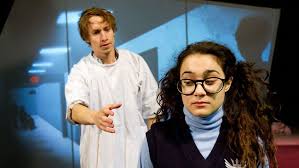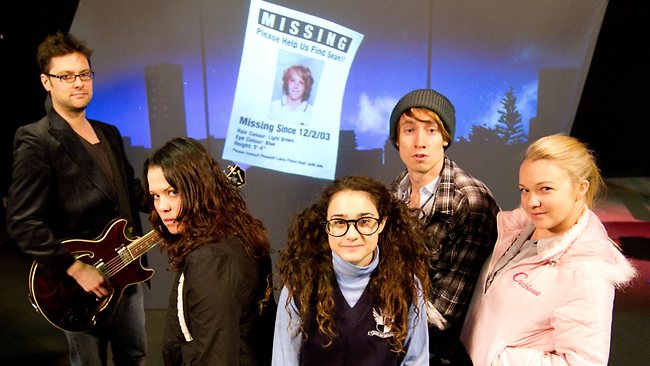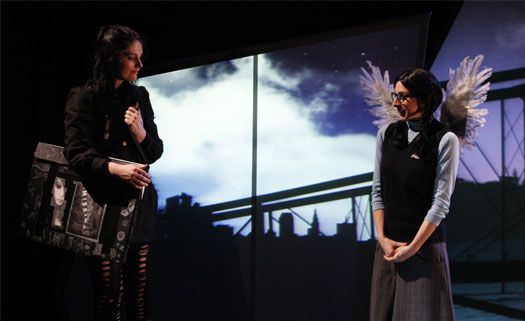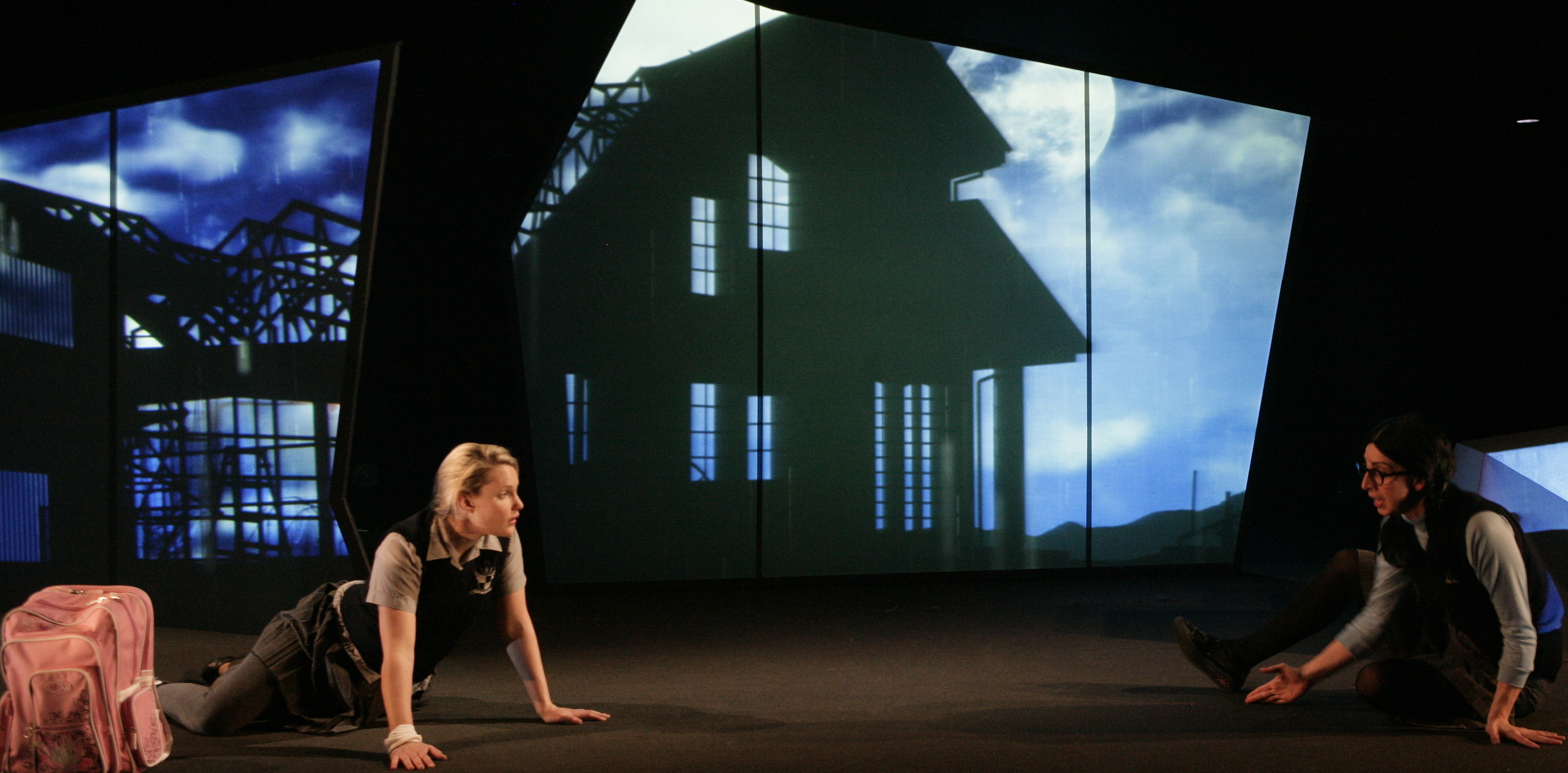AustLit
-
The unit of work below has been created to study Girl Who Cried Wolf, by Angela Betzien. The work covers both practical and theory elements which allow students to build on their knowledge throughout the progress of the unit. The lesson plans are purely examples which are adaptable and have the ability to be re-worked to meet specific class needs and circumstances.
-
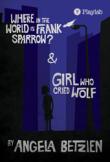 Play Cover by PlaylabSee full AustLit entry
Play Cover by PlaylabSee full AustLit entry'The most popular girl at school has disappeared prompting a lockdown in the suburb of Pleasant Lakes. Fear and hysteria grips the community. But all is not what it seems as two girls form an unlikely connection and collude in the construction of a gigantic lie.
Inspired by media reports involving the story of a girl who faked her own abduction, Girl Who Cried Wolf examines the cult of celebrity and the machinations of the school playground hierarchy. Set against the backdrop of a local shopping mall's Idol competition, an awkward 11 year old girl suffers the pain of growing up differently in a claustrophobic new housing estate in the outer suburban sprawl, anywhere and everywhere in contemporary Australia.
(...more)Characters
Narrator
Boy
Felix Dijon
Laura Black
Catriona Dijon
Joe Black
Teacher
Ada
Ryan Smalley
Idol M.C.
Principal
Mr Neat
Detective 1 & 2
Reporter
Locals
NOTE: The play can be performed by four or more actors.
Themes
School Popularity
Fake Abduction
School hierarchy
Self-Identity
Honesty vs Deception
Setting
A suburb of Pleasant Lakes, a Dolphin Development Estate.
-
The aim of this stage is to gain an initial idea of student knowledge. The activities below will assist knowledge building and act as a primary point of reference for the play
Introductory Activity
This quick activity will allow students to think about the basic concept of the play. Present the class with the story of The Boy Who Cried Wolf. Gauge an interest in the response and select one of the two options below:
1) Most understand the story
Ask students the following questions:
- What is the story about? Main concepts, themes, plot etc.
- What lesson do we learn from the story?
2) Little understanding of the story
- Get a copy of the text for the class. As a class, read the story and go back to option one.
This is a simple activity that will easily take one class, if not the first 5 minutes (depending on the option you select).
Personal Response to Girl Who Cried Wolf
Set one class aside to read Girl Who Cried Wolf. After reading the play, ask students for homework or as an in class activity to write a critical reflection by drawing upon the play, the activities completed prior and their own thoughts on the text. Use student responses for a classroom discussion to create posters of characters, plot and themes.
Key Elements of the Text
Plot
- Timeline the events of Catriona and Laura, think about their personal events and their relationship as well as the main events of the play. Upon looking at the final timeline, students should be able to easily point out what happened and when. From this, they will be able to synthesise the information and place it into critical conversation. In the next lesson (depending on timetabling), ask students to think about the significance of each event: why did it happen (both in time and in relation to the play overall)? What does it reveal about the entirety of the play? Is there anything left unanswered?
- Dedicate time for students to revisit the play for a skim read. Depending on how you initially read the text, will depend on the student response to the activity. Ask students to present what they think the turning point of the play is? Students will back up their thinking by drawing on specific lines of the text.
Character
- Each character along the way represents notions of Australian Gothic. Create a table with two columns (Character and Gothic Representation) and ask students to pick a specific character and put it into conversation with basic understandings of what they have learnt about Australian Gothic theatre.
- As a practical exercise in small groups, get students to select a scene where the Narrator is involved. The Narrator in the text isn't physically represented. However, allow students to explore the Narrator in other ways. For example:
Place the narrator on stage.
- What effect occurs by physically seeing the narrator? Does anything change?
- Would it be more effective to have the Narrator on stage? Why or Why not? Would the play lose its natural feel?
Give the lines of the Narrator to another character that best seems fit. (change to first person where necessary).
- Is there a new reading of the play?
- What effect does placing this aspect on a specific character have?
- Is any dramatic meaning lost?
Eliminate the Narrator all together.
- Are any gaps left within the play? If so, what is left unanswered? Could you seek missing information from somewhere else?
- Does the play rely heavily on that of the Narrator?
Themes
- Consider the main theme of honesty vs deception. Ask students to discuss its literal and figurative existence within the play.
Literal Questions:
- How does the literal representation affect the characters?
- Describe its interaction with the play overall.
- Why use a literal approach with something that is more figurative?
- What is the purpose?
Figurative Questions:
- How is honesty vs deception figurative within the text? Is it through characters, interpretation or themes?
- Can any literal representations be deemed figurative through a different perspective?
- In what way does the figurative lens impact our reading of the text?
- What is the purpose?
- Choose a scene for a practical session where the characters are searching for self-identity or where self-identity is troubled or is viewed as an issue within the overall context of the play. Is there a time where self-identity is symbolized through landscape or specific items? Catriona is searching for her identity, how is Laura assisting/diminishing her ability to do that?
-
The aim of this stage is to dig deeper into critical thinking, exploration and understanding of the play. Students will draw on their own interpretation and will also concentrate on the hidden messages in the text.
Semiotics of Drama
- Voice: The Delivery of Dialogue – dynamic range, intonation and vocal quality.
- Sound design: The meaning and effects of diegetic and non-diegetic sounds and music.
- Costume: The appropriateness to individual characters.
- Set design: Consider the use of space vertically/horizontally and colour. What is the set trying to convey?
- Lighting: How it is used - realistically/symbolically? Consider the relationship to the staging and overall aspect of the play.
Note: Narrow focus of semiotics for Grade 7 and 8. Starting basis to build on in Grade 9 to 12.
Consider the below images from two productions of the play and The Forge, SA production highlights video. Either as a class, in small groups or individually, discuss the similarities and differences in the understanding to that of the original text. Provide reasoning and specific examples from both text and visual aid in relation to the semiotics above. Furthermore, speak about the Gothic nature of the text and how each visual stimulus portrays it.
-
To further the close reading skills of the class, select one or as many as needed of the below and get the class to think both critically and reflectively about Girl Who Cried Wolf.
Language
- How would you describe the language of the play?
- Is it effective for the play? Yes, why? No, what language should have been used?
- Select a major and minor character. What is there language style? Does it change from the beginning of the play to the end? Is it appropriate/does it work within the context of the play?
Voice
- Who's voice cried wolf? Provide an example and explain.
- Who is the main voice of the play? Who is our go to character?
- Choose either Laura or Catriona. Follow their voice throughout the play and ask yourself: What is their voice representing? Is it a particular theme or idea? Does the representation of their voice change throughout the play?
- What do you think of the child's voice? Who is he? What is he doing there? What could be the authors intention? What do you interpret the voice to be representing?
Structure
- Does the structure work for a Gothic piece of theatre? What aspects are traditionally Gothic? What could be interpreted as Gothic?
- Consider the structure of the reporter and detective scenes? What meaning do these scenes bring to the entire play? Is it a specific meaning?
- Re-consider The Boy Who Cried Wolf in line with the text. Ask students, what are the similarities/differences in structure? What makes more sense structure wise, in exploring the metaphorical nature of the crying wolf - the fable or the play?
-
The aim of this stage is to understand the multiple perspectives and/or layers of the play. This will allow students to gain insight into its significance and idea that the play text offers in hindsight.
The play focuses on multiple Australian events, in particular, the White Australian anxiety. In perfect truth, the ideology is something Gothic in itself. The 'lost child' has siginifcant historical value and adds to characteristics of the Australian landscape. Ask students to read the article from The Conversation, The ‘lost child’ is a white Australian anxiety about innocence. After reading the article, place it in conversation with the play text and the following questions.
- How is the 'lost child' represented in the play?
- Describe the relationship, using the article, between the Boy and Laura.
- Consider the quote below. How do we see this idea within Catriona? View the question through the quote but also through the figure of her parents. Do we feel more sympathetic towards Catriona because of this?
"I think the lost child also reflects an anxiety about an uncertain future. We’ve all heard that old chestnut, “children are our future”. The children of today will carry on our names, keep our country ticking along after we die. What happens when these enablers of futurity vanish?" (The Conversation).
- Carrying raw and deep emotions, the 'lost child' idea is a significant characteristic not only within the play, but in modern day society. Why did the playwright aim this play at the younger generations? Would it be less or more appropriate to stage the play in the modern day? How would the audience of reacted in 2008 to this play? What reaction would it receive by audiences in 2016?
-
The aim of this stage is to finalise and expand on information and knowledge taught throughout the unit of work. This stage is most useful for assessment purposes and therefore, would allow teachers to assess students ability and comprehension of Girl Who Cried Wolf.
Forming
- For this task, students will write a 2-3 minute dramatic Monologue, approximately 200-300 words, that informs the audience further about a character's life. The monologue must be able to fit within the plot line of the play and not change the outcome of any of the characters. Students must submit along with the script a notes page that gives a synopsis of the monologue and where in the play it fits. Allow students an opportunity to present their monologues in a class after the assessment is due.
Performing
- Select a scene from the text that engages with the 'lost child' representation. Ask students to demonstrate in any creative style they choose (acting, oral presentation, formal address), how the scene highlights the 'lost child' and furthermore, how it utilises Australian Gothic theatre tropes? Students will work in small groups on this assessment and should be able to demonstrate the knowledge, ideas and Gothic understandings they have learnt from the unit of work.
Responding
- Ask students to develop a response to the following question: How is Girl Who Cried Wolf Australian Gothic and how is it represented within the play? The word count for the essay is 300-400 words and students should encounter the knowledge, ideas and concepts learnt throughout classroom activities.
Please Note: These are only examples and can be altered, changed and/or adapted to individual teaching needs.
-
The above class work and assessment will allow students from Grade 7 and above to meet the requirements of most, if not all, content bands and descriptors listed within the national curriculum. Below is the standard that students of Grade 7-8 must meet in order to receive a passing mark.
"By the end of Year 8, students identify and analyse how the elements of drama are used, combined and manipulated in different styles. They apply this knowledge in drama they make and perform. They evaluate how they and others from different cultures, times and places communicate meaning and intent through drama.
Students collaborate to devise, interpret and perform drama. They manipulate the elements of drama, narrative and structure to control and communicate meaning. They apply different performance styles and conventions to convey status, relationships and intentions. They use performance skills and design elements to shape and focus theatrical effect for an audience." (ACARA).
You might be interested in...



